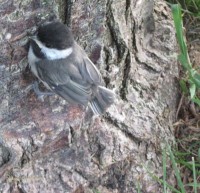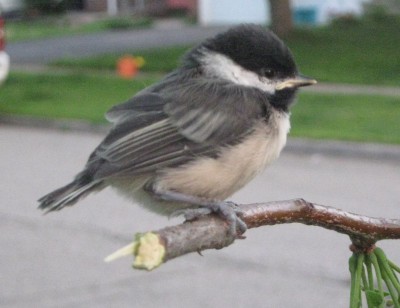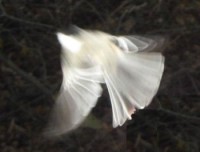…Or Don’t Be Too Quick With That Pruning Saw
Our ornamental late-flowering crabapple tree is slowly dying. The tree generously bears tiny fruit which help our resident robin survive the winter. This subdivision of Mississauga, near Toronto Ontario, was built about 40 years ago and the tree was probably planted then.
When one of the main branches dies we watch closely and decide how and where to prune. The first branch to die was over the sidewalk and it could have come crashing down on someone’s head. Rather than cut it off flush with the trunk, though, we left a stub sticking out about 3 feet. Why? Because of a tiny cheerful face.
Do Chickadees Shelter In Holes in Trees During the Ontario Winter?
That winter, while walking past the tree, I had noticed a chickadee erupt out of a perfectly round hole in the branch. I had read that chickadees will sometimes sleep inside nesting cavities to get out of the harsh winter wind. Here was a cheerful chipper bird telling me it was true.
Every morning afterwards, I made a point of looking up at the hole. Several times I caught a face peeking out at me.
The hole may have been excavated by the chickadee itself, but I’m suspicious a Downy woodpecker was involved. We regularly have Downys visit the tree, inspecting it for food and adding a hole here or there. The Downy could even have nested here. According to Cornell University Downys’ “entrance holes are round and 1-1.5 inches across…. [and they] place the entrance hole on the underside” of the branch. This is a good description of the hole here.
So when we pruned, we left the hidey hole with a foot or so of branch beyond it. I was very curious whether our welcome winter warmth-seeker would become our spring nester.
During the spring we did still see chickadees in and around the crabapple. That’s not unusual though, and was no guarantee that anyone was nesting in the branch.
A Dying Crabapple Tree Provides an Urban Home for a Black-capped Chickadee Family
Then, one glorious early evening in late May my kids came racing inside to get sunflower seeds. When I thought to wonder why, I had to follow them outside to ask. And there on the grass under the tree was a small, almost tailless fluff ball.
 The young chickadee had fluttered down from the tree and had no noticeable interest in getting back up. The parent birds kept coming nearby, chirping encouragement and keeping an eye on us. (We stayed well back at first. The sunflower seeds were being lightly tossed ahead of the uninterested bird.)
The young chickadee had fluttered down from the tree and had no noticeable interest in getting back up. The parent birds kept coming nearby, chirping encouragement and keeping an eye on us. (We stayed well back at first. The sunflower seeds were being lightly tossed ahead of the uninterested bird.)
Then Junior decided to go on the Long March. Without any comprehension of the danger, it hopped and fluttered out into the road. At one point I actually had to go out and flag a car down to stop it from squishing our hatchling. (Or at least terrifying it by driving over top.)
Upon reaching the far shore, the baby tried a few times to get a grip on the bark of a tree and flutter up. It was exhausting even to us to watch it try, then slide helplessly back down to the grass again.
 The parent birds seemed to be getting more anxious and so were we. Dusk had fallen and soon the cats and raccoons would be out and about. While we couldn’t guarantee this little one would stay there, we wanted to help the fledgling to higher ground.
The parent birds seemed to be getting more anxious and so were we. Dusk had fallen and soon the cats and raccoons would be out and about. While we couldn’t guarantee this little one would stay there, we wanted to help the fledgling to higher ground.
A long leafy branch discarded from an earlier game by another family provided a much-needed tool. With minimal coaxing, the clumsy chickadee was encouraged to climb aboard. The branch was then lifted level with some tree branches, and the fledgling transferred successfully in among the leaves.
We left then and could only hope it would stay safely there overnight. Perhaps it did. Or perhaps it fluttered down again and was lost. I prefer to imagine the former.
So as each branch of our crabapple dies, we carefully inspect it. The original stub now has three entrance holes. Whether any are in use is debatable. Each new deadwood branch is assessed to see if it is likely to land on anyone. If not, then only the most brittle older twigs are pruned.
This old crabapple may not look like the best tree on the block, but it’s home to some of the nicest neighbours.
Join In
Do you have birds nesting in your yard? What type of nesting sites are in use? Please share your experiences with a comment.

